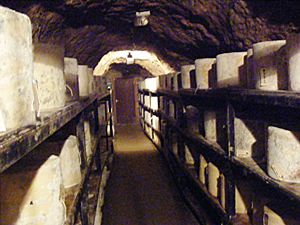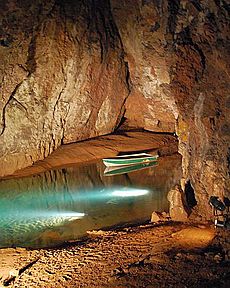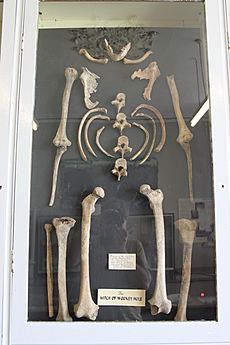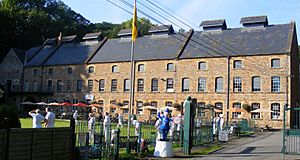Wookey Hole Caves facts for kids
Quick facts for kids Wookey Hole Caves |
|
|---|---|
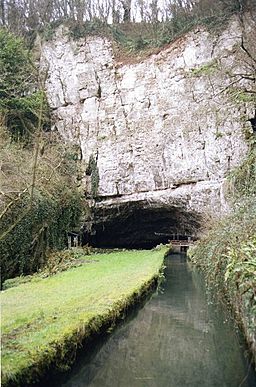
The River Axe emerging from Wookey Hole Caves
|
|
| Location | Wookey Hole, Somerset, UK |
| OS grid | ST 5319 4802 |
| Depth | 90 metres (300 ft) |
| Length | 4,380 metres (14,370 ft) |
| Height variation | 150 metres (490 ft) |
| Elevation | 64 metres (210 ft) |
| Geology | Dolomitic conglomerate and limestone |
| Entrances | 6 (incl. 1 artificial, 1 blocked) |
| Access | Restricted |
| Show cave opened | 1927 |
| Lighting | Electric |
| Registry | MCRA |
The Wookey Hole Caves are amazing limestone caves and a popular tourist spot in Wookey Hole, Somerset, England. The River Axe flows right through these caves. It's a special place, known as a Site of Special Scientific Interest (SSSI), because of its unique plants, animals, and geology.
Wookey Hole is a "solutional cave". This means it formed when natural acids in groundwater slowly dissolved the rocks over thousands of years. The water comes from rain that soaks into the ground. The temperature inside the caves stays at a cool 11 °C (52 °F) all year round.
People have used these caves for about 45,000 years! Tools from the Paleolithic (Stone Age) period have been found here, along with old animal bones. Later, people from the Iron Age and even Roman Britain lived or worked near the caves. For hundreds of years, the river flowing from the caves has powered a paper mill, which is one of the oldest in Britain. The cool, steady temperature inside the caves is also perfect for maturing Cheddar cheese.
Wookey Hole is famous for being the site of the first cave dives in Britain. Brave divers have explored many parts of the cave system since the 1930s. About 4,000 metres (13,000 ft) of passages, including 25 chambers, have been explored so far. Part of the cave opened to visitors in 1927. The cave is also known for the legend of the Witch of Wookey Hole, a stalagmite that looks like a human. It's said to be a witch turned to stone! The caves have even been used as a filming location for TV shows like Doctor Who.
Contents
Exploring Wookey Hole Caves
The part of the cave you can visit has a dry passage connecting three big chambers. The first chamber is where you can see the famous Witch of Wookey formation. There are also higher passages leading off from these main chambers.
The River Axe flows through the third and first chambers. It then goes through two underwater sections, called sumps, before flowing out into the open air.
Normally, some parts of the cave, like the fourth and fifth chambers, are only reachable by diving. But there's an artificial tunnel, about 180 metres (590 ft) long, that lets visitors walk across bridges over the seventh and eighth chambers. This tunnel also takes you past the ninth chamber before you exit near where the river comes out. Another tunnel, 74-metre-long (243 ft), was dug in 2015 to allow visitors to see the 20th chamber.
Beyond the areas open to the public, the cave system continues with many more chambers and underwater passages. Divers have explored deep sumps, reaching depths of 90 metres (300 ft). The very end of the explored cave system is about 1,000 metres (1,100 yd) northeast of the entrance.
How the Caves Formed
Wookey Hole is located on the edge of the Mendip Hills. It's where water from the hills comes out of the ground. This is the second largest "resurgence" (where an underground river comes to the surface) in the Mendips.
The caves are mainly formed in limestone rock. This happens through a process called weathering, where naturally acidic groundwater slowly dissolves the rock. The first part of the cave is special because it's formed in a different type of rock called Dolomitic Conglomerate. This rock is like a mix of pebbles and sand cemented together.
Over time, as the land changed and river levels dropped, some passages in the cave were left dry. The way the passages look depends on the type of rock they formed in. Some parts are wide and low, while others are tall and narrow, like 'rifts'. In the deepest parts of the cave, the passages go down to 26 metres (85 ft) below sea level!
History of Human Use
The name Wookey might come from an old Celtic word for 'cave'. So, "Wookey Hole Cave" basically means "cave cave cave"! The caves were first written about in 1681.
Scientists have found fossils of many animals in the caves, including ancient lions, hyenas, and badgers. Humans lived in or near Wookey Hole during the Iron Age, around 250-300 BC. There's also evidence of Stone Age hunters and Roman settlements. Foundations of a 1st-century hut were found just outside the cave entrance.
In the 1500s, signs of Roman lead mining were found in the area. The lead from these mines affected the water quality in the caves, which even impacted the paper made at the mill.
The cool 11 °C (52 °F) temperature inside the caves is perfect for maturing Cheddar cheese. A company called Ford Farm uses a special "Cheese Tunnel" in the caves for this purpose.
Cave Archaeology
Archaeologists have been studying Wookey Hole for a long time. William Boyd Dawkins started excavations in the 1800s. He found the first proof that Stone Age humans lived in the Mendip Hills caves. Tools from the Middle Paleolithic period, about 41,000 years old, have been found with animal bones that show signs of being butchered.
Herbert E. Balch continued this work in the early 1900s. He found Roman coins from the 3rd century and ancient flint tools. Later work even showed that one of the cave chambers was used as a Roman-British cemetery.
Cave Exploration and Diving
The first three chambers of the cave have been known since at least the Iron Age. But the parts beyond that are underwater. Graham Balcombe led the first successful cave dives in Britain here in 1935. He used special diving gear to reach the seventh chamber.
Diving continued after World War II. Divers found Roman-British remains, which led to important archaeological work. The large ninth chamber was first reached in 1948. Exploring deeper parts of the cave was very challenging due to the depth and strong currents. Sadly, two divers lost their lives exploring the caves in 1949 and 1981.
New diving equipment and techniques, like open circuit air diving and wetsuits, helped divers go further. In 1966, Dave Savage reached the 18th chamber. Later, John Parker explored the 20th chamber and followed the River Axe upstream to the 22nd chamber.
In the 1970s, explorers found the way on from the 22nd chamber. Divers like Colin Edmond, Martyn Farr, Geoff Yeadon, and Oliver Statham pushed further. They reached the 23rd and 24th chambers, describing the river passage as "magnificent." Finally, Farr reached the 25th chamber, a muddy place called "The Lake of Gloom."
The 25th chamber is the furthest air space found upstream. From here, the River Axe comes from a very deep sump. Divers like John Volanthen and Rick Stanton have set new British depth records here, reaching 90 metres (300 ft) in 2005.
The Legend of the Witch
There's a famous old legend about a "witch of Wookey Hole." This story is why a stalagmite in the first chamber is called the Witch of Wookey.
The story goes that a witch lived in the caves and cursed a young couple's romance. The man, who became a monk, wanted revenge. He followed the witch into the cave. The monk then blessed the water and splashed it at the witch. The blessed water immediately turned the witch to stone, and she has been there ever since.
In 1912, a 1000-year-old skeleton was found in the caves. People often linked it to the legendary witch. However, studies showed that the bones belonged to a man, aged between 25 and 35. These remains are now in the Wells and Mendip Museum.
The legend of the witch even led the TV show Most Haunted to visit the caves in 2009 to look for ghosts. In 2009, a new actor was chosen to play the 'witch' at Wookey Hole, picked from over 3,000 people!
Visiting Wookey Hole
The caves first opened to the public in 1927. The current paper mill building, powered by the river, dates back to around 1860. While the mill no longer makes paper commercially, visitors can still watch a video about how paper was made there.
Besides the caves, Wookey Hole has many other attractions. These include a dinosaur valley, a museum about the cave and cave diving, a theatre with circus shows, a house of mirrors, and penny arcade games.
In the 1970s, the famous Madame Tussauds company owned the cave and mill. Today, the owner is Gerry Cottle, a former circus owner, who has even started a circus school there.
The caves have been used as a filming location for several TV shows. They appeared in the BBC series Doctor Who for the episodes Revenge of the Cybermen (1975) and "The End of Time" (2009). They were also used for Blake's 7 (1978) and Robin of Sherwood (1983).


